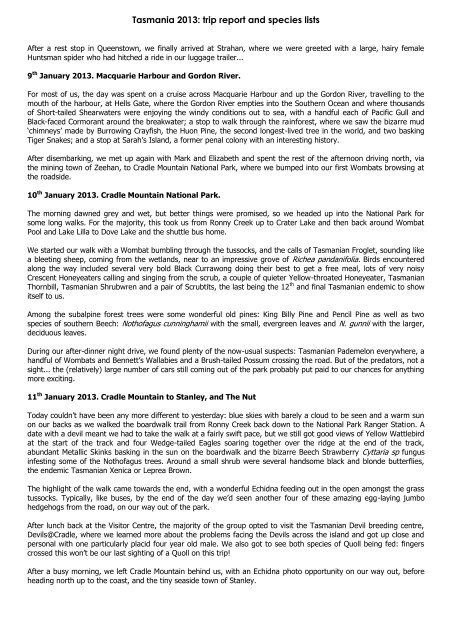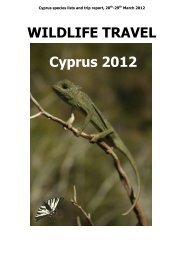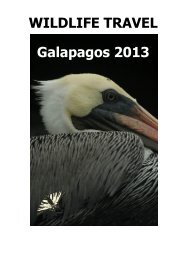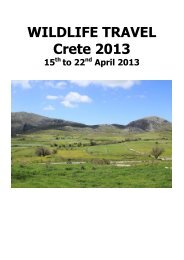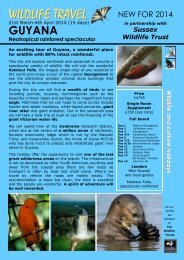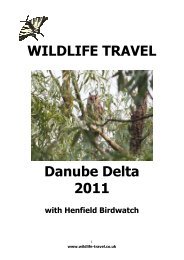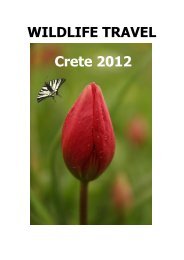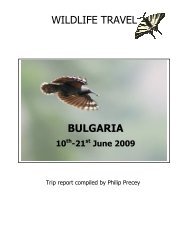WILDLIFE TRAVEL TASMANIA
Tasmania 2013 - Wildlife Travel
Tasmania 2013 - Wildlife Travel
Create successful ePaper yourself
Turn your PDF publications into a flip-book with our unique Google optimized e-Paper software.
Tasmania 2013: trip report and species lists<br />
After a rest stop in Queenstown, we finally arrived at Strahan, where we were greeted with a large, hairy female<br />
Huntsman spider who had hitched a ride in our luggage trailer...<br />
9 th January 2013. Macquarie Harbour and Gordon River.<br />
For most of us, the day was spent on a cruise across Macquarie Harbour and up the Gordon River, travelling to the<br />
mouth of the harbour, at Hells Gate, where the Gordon River empties into the Southern Ocean and where thousands<br />
of Short-tailed Shearwaters were enjoying the windy conditions out to sea, with a handful each of Pacific Gull and<br />
Black-faced Cormorant around the breakwater; a stop to walk through the rainforest, where we saw the bizarre mud<br />
‘chimneys’ made by Burrowing Crayfish, the Huon Pine, the second longest-lived tree in the world, and two basking<br />
Tiger Snakes; and a stop at Sarah’s Island, a former penal colony with an interesting history.<br />
After disembarking, we met up again with Mark and Elizabeth and spent the rest of the afternoon driving north, via<br />
the mining town of Zeehan, to Cradle Mountain National Park, where we bumped into our first Wombats browsing at<br />
the roadside.<br />
10 th January 2013. Cradle Mountain National Park.<br />
The morning dawned grey and wet, but better things were promised, so we headed up into the National Park for<br />
some long walks. For the majority, this took us from Ronny Creek up to Crater Lake and then back around Wombat<br />
Pool and Lake Lilla to Dove Lake and the shuttle bus home.<br />
We started our walk with a Wombat bumbling through the tussocks, and the calls of Tasmanian Froglet, sounding like<br />
a bleeting sheep, coming from the wetlands, near to an impressive grove of Richea pandanifolia. Birds encountered<br />
along the way included several very bold Black Currawong doing their best to get a free meal, lots of very noisy<br />
Crescent Honeyeaters calling and singing from the scrub, a couple of quieter Yellow-throated Honeyeater, Tasmanian<br />
Thornbill, Tasmanian Shrubwren and a pair of Scrubtits, the last being the 12 th and final Tasmanian endemic to show<br />
itself to us.<br />
Among the subalpine forest trees were some wonderful old pines: King Billy Pine and Pencil Pine as well as two<br />
species of southern Beech: Nothofagus cunninghamii with the small, evergreen leaves and N. gunnii with the larger,<br />
deciduous leaves.<br />
During our after-dinner night drive, we found plenty of the now-usual suspects: Tasmanian Pademelon everywhere, a<br />
handful of Wombats and Bennett’s Wallabies and a Brush-tailed Possum crossing the road. But of the predators, not a<br />
sight... the (relatively) large number of cars still coming out of the park probably put paid to our chances for anything<br />
more exciting.<br />
11 th January 2013. Cradle Mountain to Stanley, and The Nut<br />
Today couldn’t have been any more different to yesterday: blue skies with barely a cloud to be seen and a warm sun<br />
on our backs as we walked the boardwalk trail from Ronny Creek back down to the National Park Ranger Station. A<br />
date with a devil meant we had to take the walk at a fairly swift pace, but we still got good views of Yellow Wattlebird<br />
at the start of the track and four Wedge-tailed Eagles soaring together over the ridge at the end of the track,<br />
abundant Metallic Skinks basking in the sun on the boardwalk and the bizarre Beech Strawberry Cyttaria sp fungus<br />
infesting some of the Nothofagus trees. Around a small shrub were several handsome black and blonde butterflies,<br />
the endemic Tasmanian Xenica or Leprea Brown.<br />
The highlight of the walk came towards the end, with a wonderful Echidna feeding out in the open amongst the grass<br />
tussocks. Typically, like buses, by the end of the day we’d seen another four of these amazing egg-laying jumbo<br />
hedgehogs from the road, on our way out of the park.<br />
After lunch back at the Visitor Centre, the majority of the group opted to visit the Tasmanian Devil breeding centre,<br />
Devils@Cradle, where we learned more about the problems facing the Devils across the island and got up close and<br />
personal with one particularly placid four year old male. We also got to see both species of Quoll being fed: fingers<br />
crossed this won’t be our last sighting of a Quoll on this trip!<br />
After a busy morning, we left Cradle Mountain behind us, with an Echidna photo opportunity on our way out, before<br />
heading north up to the coast, and the tiny seaside town of Stanley.


